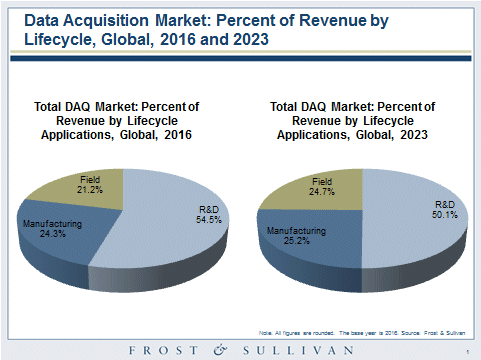By Jessy Cavazos, Industry Director, Test & Measurement
Time-sensitive networking (TSN), a new IEEE standard, promises to provide a great opportunity for data acquisition (DAQ) market participants. Over the last 20 years, Ethernet technology has spread from information technology (IT) and computer networking to consumer products. With Ethernet-based protocol now used in passenger vehicles, aircraft, automation, and robotics, Ethernet has become the backbone for communication. However, engineers have also created a number of different Ethernet-based real-time buses over the years, requiring DAQ competitors to spend time and effort to work with each bus. With TSN, there is now the possibility to eliminate these different field buses and bring to the industry a single standardized real-time bus that will help DAQ companies communicate with different participants in a standardized way and bring their core technology into different applications.
TSN versus Previous Standards
Although efforts have been made in terms of EtherCAT since 2009/2010, and this standard has been well adopted in durability and powertrain testing, benefiting from the support of all large testing participants, TSN will be a significant development for DAQ vendors as EtherCAT is not IEEE-standardized. Up until TSN, EtherCAT and other standards, such as ProfiNET RT, were driven by industrial leaders that typically support their technology in their target market and often in specific applications. In contrast, with Ethernet completely standardized, distributed DAQ in real-time and automation can be achieved with a simple Ethernet-based chip. Products from different DAQ vendors can be connected to one another and can even connect with other types of instrumentation to become one large network. With TSN, vendors can use what is available, and they do not have to standardize anything. In future, this could lead to a plug-and-play world for the customer.
TSN will Put the Onus on DAQ Vendors’ Core Competencies
TSN means intense competition for DAQ vendors that have to differentiate themselves through their core competencies. Thus, companies’ technical expertise and their intellectual property through patents will increase in importance, along with their ability to support customers in terms of data analysis and offer them actionable insights. The Industrial Internet of Things (IIoT) comprises various factors, including Internet integration, Web connections in devices, and other concepts and functionalities. With the march toward a digitalized industry, DAQ companies must choose the areas of focus for their resources. Most of these companies are fairly small organizations that face significant pressure in terms of time and human resources. With TSN, DAQ vendors will be able to dedicate their time and effort to analyze the large amount of data generated by customers’ testing activities and eliminate the time wasted on synchronizing devices.
TSN and IIoT
Providing the capabilities needed for the distribution of disparate measurement systems while retaining system-level synchronization, TSN will play a central role in the evolution of distributed DAQ systems, for which demand has been growing with IIoT. Field DAQ systems that will inspect, test, and verify smart products and other equipment, once deployed, are also seeing rising demand. In addition, as product complexity increases, more data and correlation between measurements will be required, driving customers’ desire to be closer to the device under test (DUT) – to avoid building highly complex systems. In addition, while there is a clear driver in the traditional DAQ space for distributed systems, there is also a natural extension from DAQ to monitoring applications for assets and structures such as wind turbines, bridges, tunnels, oil, gas, and water pipelines, and industrial machinery. The rising volume of wind turbines, in particular, is a key growth driver for DAQ implemented for monitoring purposes. This also translates into demand for more rugged DAQ equipment as these systems are to be placed in proximity to the DUT.
For IIoT purposes, IT systems must converge with operation technology (OT) systems; however, the different underlying technologies used in these spaces make this convergence troublesome, with potentially dire consequences such as damage to a machine or a part it is producing. A new technology is needed to enhance Ethernet with the deterministic operations required by OT systems. 802.1AS, the synchronization technology behind TSN, is the key to overcome these issues by adding precise time synchronization, significantly increasing Ethernet’s time performance.
TSN-enabled DAQ Products will Emerge
Recent research performed on the DAQ market indicates that vendors, including DAQ market leader National Instruments and structural durability test expert HBM, are excited about TSN. DAQ products that utilize TSN are emerging in the market, with the most recent introduction being that of new FieldDAQ devices by National Instruments in December 2017 – these are rugged and TSN-enabled, making it easy for customers to implement distributed DAQ systems in demanding field applications. Over the next 7 years, Frost & Sullivan foresees significant growth for DAQ vendors from field applications, and it projects this segment to record the highest compound annual growth rate (CAGR) from 2016 to 2023 when compared to the research and development (R&D) and the manufacturing applications.

For more information on the global DAQ market, please click here or contact Industry Director Jessy Cavazos at [email protected].



